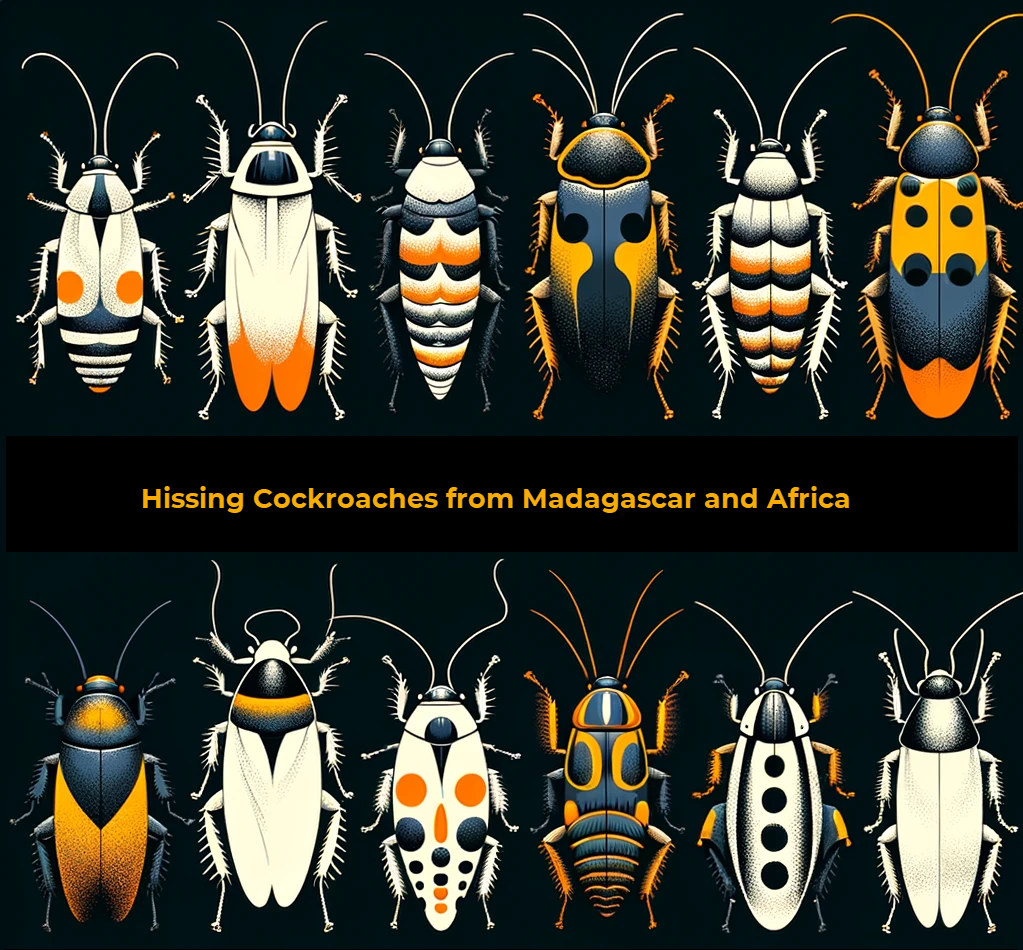Hissing Cockroaches: Masters of Sound Among the Roach Kingdom
 Hissing cockroaches, with the Madagascar Hissing Cockroach (Gromphadorhina portentosa) at the forefront, represent some of the most fascinating members of the cockroach world. Renowned for their distinctive hissing sound, these insects offer a glimpse into the diverse behaviors and characteristics that cockroaches can exhibit. This post explores the world of hissing cockroaches, their unique traits, and the intriguing possibility of keeping them as pets.
Hissing cockroaches, with the Madagascar Hissing Cockroach (Gromphadorhina portentosa) at the forefront, represent some of the most fascinating members of the cockroach world. Renowned for their distinctive hissing sound, these insects offer a glimpse into the diverse behaviors and characteristics that cockroaches can exhibit. This post explores the world of hissing cockroaches, their unique traits, and the intriguing possibility of keeping them as pets.
The Madagascar Hissing Cockroach: A Closer Look
Unique Behaviors and Characteristics
The Madagascar Hissing Cockroach stands out due to its size, reaching up to 3 inches in length, and its lack of wings, unlike many other cockroach species. What truly sets it apart, however, is its ability to produce a hissing sound by expelling air through its spiracles. This behavior serves multiple purposes, including communication, mating, and deterring predators.
Habitat and Lifestyle
Native to the island of Madagascar, these cockroaches thrive in the forest floor’s decaying matter. Their diet primarily consists of fruit and vegetable material, making them detritivores that play a crucial role in their ecosystem.
Beyond Madagascar: Other Hissing Cockroaches
While the Madagascar species is the most well-known, several other cockroaches also possess the ability to hiss, each with its own set of behaviors and adaptations:
- Gromphadorhina oblongonota (Wide-Horned Hissing Cockroach): Notable for its larger size and more pronounced “horns” compared to G. portentosa.
- Elliptorhina javanica (Halloween Hissing Cockroach): Features a striking coloration that makes it a favorite among enthusiasts.
- Aeluropoda insignis (Insignis Hissing Cockroach): Known for its quieter hiss and smoother body texture.
Keeping Hissing Cockroaches as Pets
Hissing cockroaches have become popular pets due to their docile nature and minimal care requirements. Here are some tips for those considering hissing cockroaches as pets:
- Habitat: A secure enclosure with ample space for climbing and hiding. Coconut fiber or peat moss can be used as substrate.
- Diet: A varied diet of fruits, vegetables, and occasional protein sources like dog food ensures proper nutrition.
- Environment: Maintain a temperature of 75-80°F and moderate humidity to mimic their natural habitat.
The African Hissing Cockroach: A Distinct Member of the Hissing Family
While the Madagascar Hissing Cockroach might be the most renowned for its vocal abilities, the African Hissing Cockroach presents its own set of intriguing characteristics that differentiate it from its Madagascan counterpart. Although not as commonly known, this species shares the hissing trait but diverges in habitat, appearance, and behavior.
Unique Traits and Lifestyle
The African Hissing Cockroach, primarily found in regions across the African continent, thrives in a variety of environments, from arid landscapes to lush forests. This adaptability speaks to the cockroach’s resilience and its role in various ecosystems as a decomposer.
- Appearance: It tends to be slightly smaller than the Madagascar species and often exhibits a darker, more uniform coloration that helps it blend into its surroundings.
- Behavior: This species is known for its more aggressive use of hissing, employing it not just for communication or mating rituals but also more frequently as a defense mechanism against predators.
Ecological Impact
The African Hissing Cockroach plays a vital role in its ecosystem, much like its Madagascan counterpart. By breaking down decaying organic matter, it contributes to nutrient cycling and supports the health of the soil and forest floor.
As Pets
While less common in the pet trade than the Madagascar Hissing Cockroach, the African species can also be kept as pets by enthusiasts interested in its unique characteristics and behavior. The care requirements are similar, focusing on replicating their natural environment to ensure their health and well-being.
Expanding Our Understanding
Adding the African Hissing Cockroach to our discussion not only broadens our appreciation for the diversity within the cockroach family but also highlights the ecological significance of these often-misunderstood creatures. Whether in the wilds of Africa or the forests of Madagascar, hissing cockroaches continue to fascinate and educate us on the complexity of nature.
| Species | Characteristics | Habitat |
|---|---|---|
| Madagascar Hissing Cockroach (Gromphadorhina portentosa) | Large size, lacks wings, produces hissing sound by expelling air through spiracles. | Forests of Madagascar, decaying matter on the forest floor. |
| Wide-Horned Hissing Cockroach (Gromphadorhina oblongonota) | Larger size, pronounced ‘horns’, similar hissing capabilities. | Similar habitats to G. portentosa, with a preference for more secluded areas. |
| Halloween Hissing Cockroach (Elliptorhina javanica) | Striking coloration, popular among enthusiasts for its appearance. | Tropical environments, with a preference for humid and warm conditions. |
| Insignis Hissing Cockroach (Aeluropoda insignis) | Quieter hiss, smoother body texture, less common in the pet trade. | Various habitats across Madagascar, adaptable to different environmental conditions. |
| African Hissing Cockroach | Slightly smaller, darker coloration, uses hissing more aggressively as a defense mechanism. | Various regions across the African continent, from arid landscapes to lush forests. |
Conclusion
Hissing cockroaches, particularly the Madagascar Hissing Cockroach, offer a unique window into the complexity and diversity of cockroach species. Whether admired for their ecological role, studied for their fascinating behaviors, or cared for as pets, these creatures challenge the conventional perception of cockroaches and reveal the beauty of biodiversity.
- The Life Span of a Cockroach
- Do Cockroaches Eat Clothes?
- Do Cockroaches Have Teeth?
- Shrimps and Cockroaches
- Will Sleeping with the Light On Keep Cockroaches Away?
- How to get roaches out of your car overnight
- Do Cockroaches Feel Pain?
- How Many Legs Do Cockroaches Have?
- Comparing Cockroach Eggs Size for Different Types of Cockroaches
- Identifying a Cockroach Bite on the Lips or Face
- Black Water Bug Identification and Control
- Why Do Water Bugs Come Out At Night?
- What Does Roach Rash Look Like?
- Can Cockroaches Bite Your Eyelid?
- Can Cockroaches Live in Your Balls?
- How did cockroaches get their name?
- Why Do Cockroaches Shed Their Skin?
- What Smell do Palmetto Bugs Hate?
- Baby Palmetto Bug: Identification and Control
- Cockroach Eggs vs Poop: How to Tell the Difference
- How to Get Rid of Water Bugs
- How Long Can a Cockroach Live Without Air?
- The Lifecycle of the German Cockroach: From Egg to Adult
- Do Mice Eat Roaches
- Wood Roach vs. Cockroach

